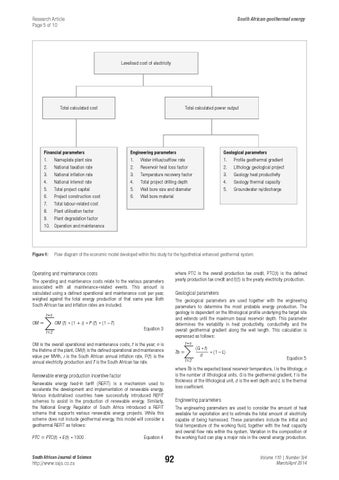Research Article Page 5 of 10
South African geothermal energy
Levelised cost of electricity
Total calculated cost
Total calculated power output
Financial parameters
Engineering parameters
Geological parameters
1.
Nameplate plant size
1.
Water influx/outflow rate
1.
Profile geothermal gradient
2.
National taxation rate
2.
Reservoir heat loss factor
2.
Lithology geological project
3.
National inflation rate
3.
Temperature recovery factor
3.
Geology heat productivity
4.
National interest rate
4.
Total project drilling depth
4.
Geology thermal capacity
5.
Total project capital
5.
Well bore size and diameter
5.
Groundwater re/discharge
6.
Project construction cost
6.
Well bore material
7.
Total labour-related cost
8.
Plant utilisation factor
9.
Plant degradation factor
10. Operation and maintenance
Figure 4: Flow diagram of the economic model developed within this study for the hypothetical enhanced geothermal system.
Operating and maintenance costs
where PTC is the overall production tax credit, PTC(t) is the defined yearly production tax credit and E(t) is the yearly electricity production.
The operating and maintenance costs relate to the various parameters associated with all maintenance-related events. This amount is calculated using a defined operational and maintenance cost per year, weighed against the total energy production of that same year. Both South African tax and inflation rates are included.
Geological parameters The geological parameters are used together with the engineering parameters to determine the most probable energy production. The geology is dependent on the lithological profile underlying the target site and extends until the maximum basal reservoir depth. This parameter determines the variability in heat productivity, conductivity and the overall geothermal gradient along the well length. This calculation is expressed as follows:
t=n
OM =
OM (t) * (1 + i) * P (t) * (1 – T) t=2
Equation 3
t=n
OM is the overall operational and maintenance costs, t is the year; n is the lifetime of the plant, OM(t) is the defined operational and maintenance value per MWh, i is the South African annual inflation rate, P(t) is the annual electricity production and T is the South African tax rate.
Tb =
Equation 5 where Tb is the expected basal reservoir temperature, l is the lithology, n is the number of lithological units, G is the geothermal gradient, t is the thickness of the lithological unit, d is the well depth and L is the thermal loss coefficient. t=2
Renewable energy production incentive factor Renewable energy feed-in tariff (REFIT) is a mechanism used to accelerate the development and implementation of renewable energy. Various industrialised countries have successfully introduced REFIT schemes to assist in the production of renewable energy. Similarly, the National Energy Regulator of South Africa introduced a REFIT scheme that supports various renewable energy projects. While this scheme does not include geothermal energy, this model will consider a geothermal REFIT as follows: PTC = PTC(t) * E(t) * 1000
South African Journal of Science
http://www.sajs.co.za
(G * t) (1 – L) d *
Engineering parameters The engineering parameters are used to consider the amount of heat available for exploitation and to estimate the total amount of electricity capable of being harnessed. These parameters include the initial and final temperature of the working fluid, together with the heat capacity and overall flow rate within the system. Variation in the composition of the working fluid can play a major role in the overall energy production.
Equation 4
92
Volume 110 | Number 3/4 March/April 2014
